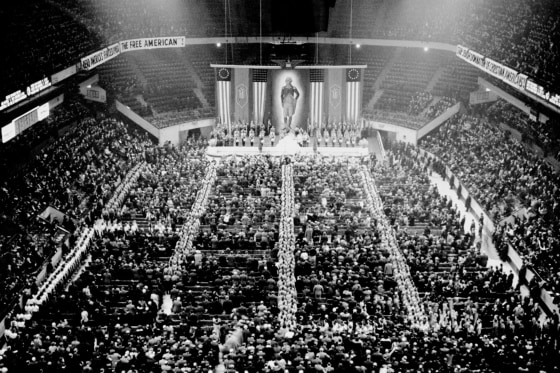In 1916, President Woodrow Wilson issued a proclamation officially establishing June 14 as Flag Day.
This year, mere days before the holiday on Monday, the Stars and Stripes fluttered into the news cycle, with New York Times editorial board member and MSNBC analyst Mara Gay’s remark, on “Morning Joe,” about a procession of vehicles she had seen on Long Island flying flags.
It is only as virtuous a symbol as the person waving — or weaponizing — it.
Gay described being “really disturbed” by the motorcade, which consisted, she said, of “dozens and dozens of pickup trucks with [expletives] against Joe Biden on the back of them, Trump flags, and in some cases just dozens of American flags. … The message was clear. ‘This is my country. This is not your country. I own this.’”
The backlash on social media against what some perceived as Gay’s disrespect for the flag, and for America itself, was as swift as it was predictable. And, after The New York Times dared to defend its editorial board member, former President Donald Trump’s acting director of national intelligence, Richard Grenell, tweeted: “Dear God....the @nytimes justifies mocking the American flag because Donald Trump likes the American flag. It’s propaganda for the ruling party. We see it.”
Gay hadn’t mocked Old Glory, of course, only expressed chagrin at how she felt it was being used. It’s easy for some to dismiss such conflation of the American flag with racism as overwrought. But not for others of us, like anyone familiar with the large 1939 Nazi rally at Madison Square Garden that decked itself in the Stars and Stripes.
Flags, of course, are symbols, and symbols can carry very different meanings in different contexts. In some Eastern religions, a swastika represents divinity or good fortune, but to most of us these days, at least in the West, the twisted-arm cross symbolizes something very different.
It was that meaning that was on display alongside the American flag when the German American Bund, a Nazi group, organized a “Pro-American Rally” — as the arena marquee proclaimed (just above “Rangers vs. Detroit”) — on Feb. 20, 1939, some six months before Nazi Germany invaded Poland and just as Hitler was completing construction of his sixth concentration camp.
The grand event began with a solemn procession of oversize American flags, with more than 20,000 right hands shooting forth like the Nazi salute as they passed. Then the Pledge of Allegiance was recited from the stage, followed by a rendition of “The Star Spangled Banner.”
The stage featured a gargantuan representation of George Washington, with equally oversize American flags flanking it. Attendees held aloft posters with slogans like “Stop Jewish Domination of Christian America.” Speeches referred to “job-taking Jewish refugees.” American flags borne by attendees were waved in approval. One of the main speakers proudly extolled militant white supremacy. When an unarmed young Jewish man rushed onstage, he was viciously beaten by attendees before police took him away.
I don’t know if any of the owners of the trucks Gay saw intended their American flags to telegraph racist sentiment. But it isn’t arguable that such sentiment exists — or that it is often accompanied, as it was in 1939 in Madison Square Garden, by American flags.
Indeed, U.S. history is rife with examples. A Pulitzer Prize-winning photo taken at a busing demonstration in Boston on April 5, 1976, shows an enraged young white man holding a large American flag like a spear and aiming it at a Black man, who was being restrained by the assaulter’s compatriot. The American flag as a weapon, wielded against an American.
In more recent memory is the image of Old Glory at the “Unite the Right” rally that took place in Charlottesville, Virginia, in the summer of 2017. The American flag in the company of Confederate and Nazi ones.
Such hijacking of the American flag by people who rightly evoke our disgust should make clear that it’s a mistake to treat the flag as a sacrosanct object. It is only as virtuous a symbol as the person waving — or weaponizing — it. Throughout American history, bigots and zealots have been more interested in co-opting the flag than using it as a lodestar. It’s not only reasonable but imperative to challenge those who appropriate the flag for anti-American sentiments.
No less than the celebrated 18th-century British writer Samuel Johnson noted that displays of “patriotism” often remain “the last refuge of a scoundrel.” Johnson was decrying what he viewed as false patriotism, as opposed to the love of one’s country that’s true patriotism. And hatred and anger and racism presented as patriotism is not only false but dangerous.
I personally don't think that the vast majority of Trump's supporters are white supremacists. But it’s well-established that neo-Nazis have embraced him as a champion of their cause.
So knee-jerk critics of Gay should cut her some slack. Her comment wasn’t about our nation’s flag but about what she sees as its co-opting by people she regards as a threat to precisely what it’s meant to stand for: gratitude for our “one nation under God, indivisible, with liberty and justice for all.”
And, as we might well ponder today, it’s that sentiment, in the end, not a piece of cloth dyed red, white and blue, that Flag Day is meant to honor.



